
Illustrative Math Alignment: Grade 6 Unit 1
Dividing Fractions
Lesson 4: How Many Groups? (Part 1)
Use the following Media4Math resources with this Illustrative Math lesson.
| Thumbnail Image | Title | Body | Curriculum Nodes |
|---|---|---|---|

|
Elementary Definition--Multiplication and Division Concepts--False Equation | False EquationTopicMultiplication and Division DefinitionA false equation is a mathematical statement that shows equality between two expressions that are not equal. |
Multiplication Expressions and Equations |
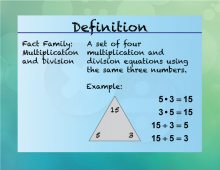
|
Elementary Definition--Multiplication and Division Concepts--Fact Family | Fact FamilyTopicMultiplication and Division DefinitionA fact family is a group of related mathematical facts using the same numbers. DescriptionFact families are sets of related addition, subtraction, multiplication, and division facts that use the same numbers. For example, the fact family for 3, 4, and 12 includes the multiplication facts 3 × 4 = 12 and 4 × 3 = 12 and the division facts 12 ÷ 3 = 4 and 12 ÷ 4 = 3 |
Multiplication Expressions and Equations |
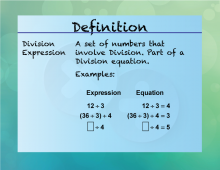
|
Elementary Definition--Multiplication and Division Concepts--Division Expression | Division ExpressionTopicMultiplication and Division DefinitionA division expression is a mathematical phrase that involves division, such as 12 ÷ 3. |
Multiplication Expressions and Equations |
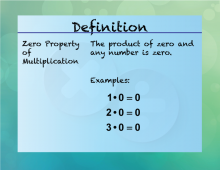
|
Elementary Definition--Multiplication and Division Concepts--Zero Property Multiplication | Zero Property of MultiplicationTopicMultiplication and Division DefinitionThe zero property of multiplication states that any number multiplied by zero equals zero. DescriptionThe zero property of multiplication is a fundamental concept in arithmetic that states multiplying any number by zero results in zero. For example, 7 × 0 = 0 |
Multiplication Expressions and Equations |

|
Elementary Definition--Multiplication and Division Concepts--Fact Family | Fact FamilyTopicMultiplication and Division DefinitionA fact family is a group of related mathematical facts using the same numbers. DescriptionFact families are sets of related addition, subtraction, multiplication, and division facts that use the same numbers. For example, the fact family for 3, 4, and 12 includes the multiplication facts 3 × 4 = 12 and 4 × 3 = 12 and the division facts 12 ÷ 3 = 4 and 12 ÷ 4 = 3 |
Multiplication Expressions and Equations |

|
Elementary Definition--Multiplication and Division Concepts--Fact Family | Fact FamilyTopicMultiplication and Division DefinitionA fact family is a group of related mathematical facts using the same numbers. DescriptionFact families are sets of related addition, subtraction, multiplication, and division facts that use the same numbers. For example, the fact family for 3, 4, and 12 includes the multiplication facts 3 × 4 = 12 and 4 × 3 = 12 and the division facts 12 ÷ 3 = 4 and 12 ÷ 4 = 3 |
Multiplication Expressions and Equations |
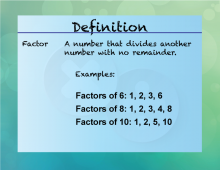
|
Elementary Definition--Multiplication and Division Concepts--Factor | FactorTopicMultiplication and Division DefinitionA factor is a number that divides another number exactly without leaving a remainder. |
Multiplication Expressions and Equations |
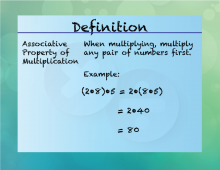
|
Elementary Definition--Multiplication and Division Concepts--Associative Property | Associative PropertyTopicMultiplication and Division DefinitionThe associative property states that the way in which numbers are grouped does not change their sum or product. |
Multiplication Expressions and Equations |

|
Elementary Definition--Multiplication and Division Concepts--False Equation | False EquationTopicMultiplication and Division DefinitionA false equation is a mathematical statement that shows equality between two expressions that are not equal. |
Multiplication Expressions and Equations |
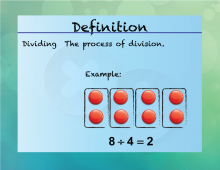
|
Elementary Definition--Multiplication and Division Concepts--Dividing | DividingTopicMultiplication and Division DefinitionDividing is the process of determining how many times one number is contained within another. |
Multiplication Expressions and Equations |

|
Elementary Definition--Multiplication and Division Concepts--False Equation | False EquationTopicMultiplication and Division DefinitionA false equation is a mathematical statement that shows equality between two expressions that are not equal. |
Multiplication Expressions and Equations |

|
Elementary Definition--Multiplication and Division Concepts--Zero Property Multiplication | Zero Property of MultiplicationTopicMultiplication and Division DefinitionThe zero property of multiplication states that any number multiplied by zero equals zero. DescriptionThe zero property of multiplication is a fundamental concept in arithmetic that states multiplying any number by zero results in zero. For example, 7 × 0 = 0 |
Multiplication Expressions and Equations |
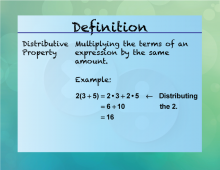
|
Elementary Definition--Multiplication and Division Concepts--Distributive Property | Distributive PropertyTopicMultiplication and Division DefinitionThe distributive property states that multiplying a sum by a number is the same as multiplying each addend by the number and then adding the products. DescriptionThe distributive property is a crucial concept in algebra and arithmetic, which states that a(b + c) = ab + ac |
Multiplication Expressions and Equations |
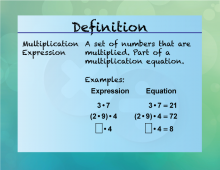
|
Elementary Definition--Multiplication and Division Concepts--Multiplication Expression | Multiplication ExpressionTopicMultiplication and Division DefinitionA multiplication expression is a mathematical phrase that involves multiplication, such as 5 × 7. DescriptionMultiplication expressions are used to represent the multiplication of numbers in a concise form. For example, the expression 6 × 8 |
Multiplication Expressions and Equations |

|
Elementary Definition--Multiplication and Division Concepts--Multiplication Expression | Multiplication ExpressionTopicMultiplication and Division DefinitionA multiplication expression is a mathematical phrase that involves multiplication, such as 5 × 7. DescriptionMultiplication expressions are used to represent the multiplication of numbers in a concise form. For example, the expression 6 × 8 |
Multiplication Expressions and Equations |
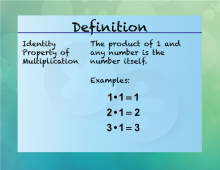
|
Elementary Definition--Multiplication and Division Concepts--Identity Property of Multiplication | Identity Property of MultiplicationTopicMultiplication and Division DefinitionThe identity property of multiplication states that any number multiplied by 1 remains unchanged. |
Multiplication Expressions and Equations |

|
Elementary Definition--Multiplication and Division Concepts--Identity Property of Multiplication | Identity Property of MultiplicationTopicMultiplication and Division DefinitionThe identity property of multiplication states that any number multiplied by 1 remains unchanged. |
Multiplication Expressions and Equations |
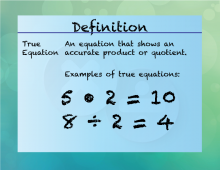
|
Elementary Definition--Multiplication and Division Concepts--True Equation | True EquationTopicMultiplication and Division DefinitionA true equation is a mathematical statement that asserts equality between two expressions that are equal. DescriptionTrue equations are essential in mathematics as they represent accurate relationships between numbers and expressions. For example, the equation 2 + 3 = 5 |
Multiplication Expressions and Equations |
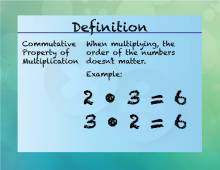
|
Elementary Definition--Multiplication and Division Concepts--Commutative Property | Commutative PropertyTopicMultiplication and Division DefinitionThe commutative property states that the order of numbers does not change their sum or product. |
Multiplication Expressions and Equations |
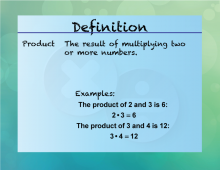
|
Elementary Definition--Multiplication and Division Concepts--Product | ProductTopicMultiplication and Division DefinitionThe product is the result of multiplying two or more numbers together. DescriptionThe product is the outcome of multiplication. For example, the product of 4 and 5 is 20. Understanding products is essential for solving problems involving multiplication and for understanding concepts such as area and volume. Products are used in various fields, including finance, engineering, and science, to model and solve real-world problems. Teaching students about products helps them develop a strong foundation in mathematics and enhances their ability to solve complex problems. |
Multiplication Expressions and Equations |

|
Elementary Definition--Multiplication and Division Concepts--Quotient | QuotientTopicMultiplication and Division DefinitionThe quotient is the result of dividing one number by another. DescriptionThe quotient is the result obtained when one number is divided by another. For example, the quotient of 20 divided by 4 is 5. Understanding quotients is essential for solving problems involving division and for understanding concepts such as fractions and ratios. Quotients are used in various fields, including finance, engineering, and science, to model and solve real-world problems. Teaching students about quotients helps them develop a strong foundation in mathematics and enhances their ability to solve complex problems. |
Multiplication Expressions and Equations |

|
Elementary Definition--Multiplication and Division Concepts--Dividing | DividingTopicMultiplication and Division DefinitionDividing is the process of determining how many times one number is contained within another. |
Multiplication Expressions and Equations |
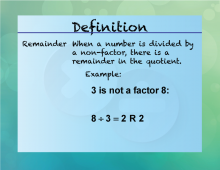
|
Elementary Definition--Multiplication and Division Concepts--Remainder | body
{
table { width: 75%; border-collapse: collapse; border: 2px solid green; margin-left:auto; margin-right:auto;} th, td { border: 1px solid green; padding: 5px; text-align: center; }
}
RemainderTopicMultiplication and Division DefinitionThe remainder is the amount left over after division when one number does not divide the other exactly. DescriptionThe remainder is the leftover amount after dividing one number by another. For example, When 17 is divided by 5, the quotient is 3 and the remainder is 2.
|
Multiplication Expressions and Equations |
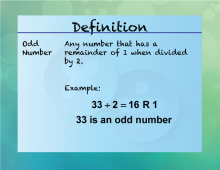
|
Elementary Definition--Multiplication and Division Concepts--Odd Number | Odd NumberTopicMultiplication and Division DefinitionAn odd number is a whole number that is not divisible by 2 with no remainder. |
Multiplication Expressions and Equations |

|
Elementary Definition--Multiplication and Division Concepts--Odd Number | Odd NumberTopicMultiplication and Division DefinitionAn odd number is a whole number that is not divisible by 2 with no remainder. |
Multiplication Expressions and Equations |
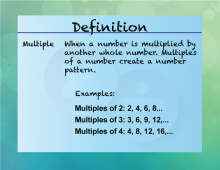
|
Elementary Definition--Multiplication and Division Concepts--Multiple | MultipleTopicMultiplication and Division DefinitionA multiple is the product of a number and a whole number. DescriptionMultiples are numbers obtained by multiplying a given number by a whole number. For example, the multiples of 3 include 3, 6, 9, 12, and so on. Understanding multiples is crucial for solving problems involving patterns, sequences, and divisibility. They are used in various real-world applications, such as scheduling, where events occur at regular intervals, and in computer science for data organization. Teaching students about multiples helps them identify patterns in numbers and develop their mathematical reasoning skills. |
Multiplication Expressions and Equations |

|
Elementary Definition--Multiplication and Division Concepts--Factor | FactorTopicMultiplication and Division DefinitionA factor is a number that divides another number exactly without leaving a remainder. |
Multiplication Expressions and Equations |

|
Elementary Definition--Multiplication and Division Concepts--Multiplication Expression | Multiplication ExpressionTopicMultiplication and Division DefinitionA multiplication expression is a mathematical phrase that involves multiplication, such as 5 × 7. DescriptionMultiplication expressions are used to represent the multiplication of numbers in a concise form. For example, the expression 6 × 8 |
Multiplication Expressions and Equations |
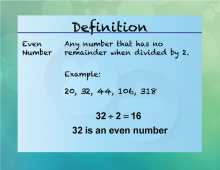
|
Elementary Definition--Multiplication and Division Concepts--Even Number | Even NumberTopicMultiplication and Division DefinitionAn even number is exactly divisible by 2. |
Multiplication Expressions and Equations |

|
Elementary Definition--Multiplication and Division Concepts--Distributive Property | Distributive PropertyTopicMultiplication and Division DefinitionThe distributive property states that multiplying a sum by a number is the same as multiplying each addend by the number and then adding the products. DescriptionThe distributive property is a crucial concept in algebra and arithmetic, which states that a(b + c) = ab + ac |
Multiplication Expressions and Equations |

|
Elementary Definition--Multiplication and Division Concepts--Division Expression | Division ExpressionTopicMultiplication and Division DefinitionA division expression is a mathematical phrase that involves division, such as 12 ÷ 3. |
Multiplication Expressions and Equations |

|
Elementary Definition--Multiplication and Division Concepts--Division Expression | Division ExpressionTopicMultiplication and Division DefinitionA division expression is a mathematical phrase that involves division, such as 12 ÷ 3. |
Multiplication Expressions and Equations |

|
Elementary Definition--Multiplication and Division Concepts--Factor | FactorTopicMultiplication and Division DefinitionA factor is a number that divides another number exactly without leaving a remainder. |
Multiplication Expressions and Equations |

|
Elementary Definition--Multiplication and Division Concepts--Multiple | MultipleTopicMultiplication and Division DefinitionA multiple is the product of a number and a whole number. DescriptionMultiples are numbers obtained by multiplying a given number by a whole number. For example, the multiples of 3 include 3, 6, 9, 12, and so on. Understanding multiples is crucial for solving problems involving patterns, sequences, and divisibility. They are used in various real-world applications, such as scheduling, where events occur at regular intervals, and in computer science for data organization. Teaching students about multiples helps them identify patterns in numbers and develop their mathematical reasoning skills. |
Multiplication Expressions and Equations |

|
Elementary Definition--Multiplication and Division Concepts--Multiple | MultipleTopicMultiplication and Division DefinitionA multiple is the product of a number and a whole number. DescriptionMultiples are numbers obtained by multiplying a given number by a whole number. For example, the multiples of 3 include 3, 6, 9, 12, and so on. Understanding multiples is crucial for solving problems involving patterns, sequences, and divisibility. They are used in various real-world applications, such as scheduling, where events occur at regular intervals, and in computer science for data organization. Teaching students about multiples helps them identify patterns in numbers and develop their mathematical reasoning skills. |
Multiplication Expressions and Equations |

|
Elementary Definition--Multiplication and Division Concepts--Even Number | Even NumberTopicMultiplication and Division DefinitionAn even number is exactly divisible by 2. |
Multiplication Expressions and Equations |

|
Elementary Definition--Multiplication and Division Concepts--Distributive Property | Distributive PropertyTopicMultiplication and Division DefinitionThe distributive property states that multiplying a sum by a number is the same as multiplying each addend by the number and then adding the products. DescriptionThe distributive property is a crucial concept in algebra and arithmetic, which states that a(b + c) = ab + ac |
Multiplication Expressions and Equations |

|
Elementary Definition--Multiplication and Division Concepts--Odd Number | Odd NumberTopicMultiplication and Division DefinitionAn odd number is a whole number that is not divisible by 2 with no remainder. |
Multiplication Expressions and Equations |

|
Elementary Definition--Multiplication and Division Concepts--Remainder | body
{
table { width: 75%; border-collapse: collapse; border: 2px solid green; margin-left:auto; margin-right:auto;} th, td { border: 1px solid green; padding: 5px; text-align: center; }
}
RemainderTopicMultiplication and Division DefinitionThe remainder is the amount left over after division when one number does not divide the other exactly. DescriptionThe remainder is the leftover amount after dividing one number by another. For example, When 17 is divided by 5, the quotient is 3 and the remainder is 2.
|
Multiplication Expressions and Equations |

|
Elementary Definition--Multiplication and Division Concepts--True Equation | True EquationTopicMultiplication and Division DefinitionA true equation is a mathematical statement that asserts equality between two expressions that are equal. DescriptionTrue equations are essential in mathematics as they represent accurate relationships between numbers and expressions. For example, the equation 2 + 3 = 5 |
Multiplication Expressions and Equations |

|
Elementary Definition--Multiplication and Division Concepts--Commutative Property | Commutative PropertyTopicMultiplication and Division DefinitionThe commutative property states that the order of numbers does not change their sum or product. |
Multiplication Expressions and Equations |

|
Elementary Definition--Multiplication and Division Concepts--Associative Property | Associative PropertyTopicMultiplication and Division DefinitionThe associative property states that the way in which numbers are grouped does not change their sum or product. |
Multiplication Expressions and Equations |

|
Elementary Definition--Multiplication and Division Concepts--Commutative Property | Commutative PropertyTopicMultiplication and Division DefinitionThe commutative property states that the order of numbers does not change their sum or product. |
Multiplication Expressions and Equations |

|
Elementary Definition--Multiplication and Division Concepts--Quotient | QuotientTopicMultiplication and Division DefinitionThe quotient is the result of dividing one number by another. DescriptionThe quotient is the result obtained when one number is divided by another. For example, the quotient of 20 divided by 4 is 5. Understanding quotients is essential for solving problems involving division and for understanding concepts such as fractions and ratios. Quotients are used in various fields, including finance, engineering, and science, to model and solve real-world problems. Teaching students about quotients helps them develop a strong foundation in mathematics and enhances their ability to solve complex problems. |
Multiplication Expressions and Equations |

|
Elementary Definition--Multiplication and Division Concepts--Product | ProductTopicMultiplication and Division DefinitionThe product is the result of multiplying two or more numbers together. DescriptionThe product is the outcome of multiplication. For example, the product of 4 and 5 is 20. Understanding products is essential for solving problems involving multiplication and for understanding concepts such as area and volume. Products are used in various fields, including finance, engineering, and science, to model and solve real-world problems. Teaching students about products helps them develop a strong foundation in mathematics and enhances their ability to solve complex problems. |
Multiplication Expressions and Equations |
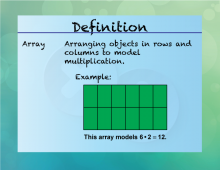
|
Elementary Definition--Multiplication and Division Concepts--Array | ArrayTopicMultiplication and Division DefinitionAn array is a systematic arrangement of objects, typically in rows and columns. |
Multiplication Expressions and Equations |

|
Elementary Definition--Multiplication and Division Concepts--Array | ArrayTopicMultiplication and Division DefinitionAn array is a systematic arrangement of objects, typically in rows and columns. |
Multiplication Expressions and Equations |
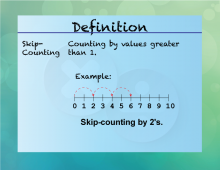
|
Elementary Definition--Multiplication and Division Concepts--Skip Counting | Skip CountingTopicMultiplication and Division DefinitionSkip counting is the process of counting forward by numbers other than one, such as by 2s, 5s, or 10s. |
Multiplication Expressions and Equations |

|
Elementary Definition--Multiplication and Division Concepts--Array | ArrayTopicMultiplication and Division DefinitionAn array is a systematic arrangement of objects, typically in rows and columns. |
Multiplication Expressions and Equations |

|
Elementary Definition--Multiplication and Division Concepts--Associative Property | Associative PropertyTopicMultiplication and Division DefinitionThe associative property states that the way in which numbers are grouped does not change their sum or product. |
Multiplication Expressions and Equations |